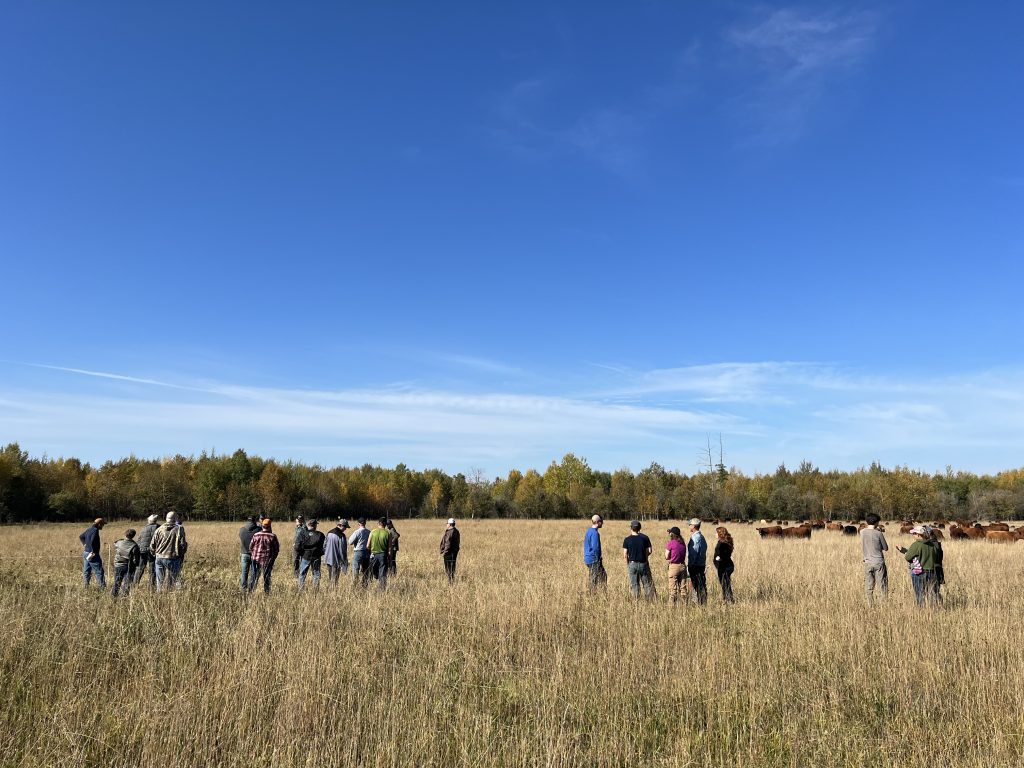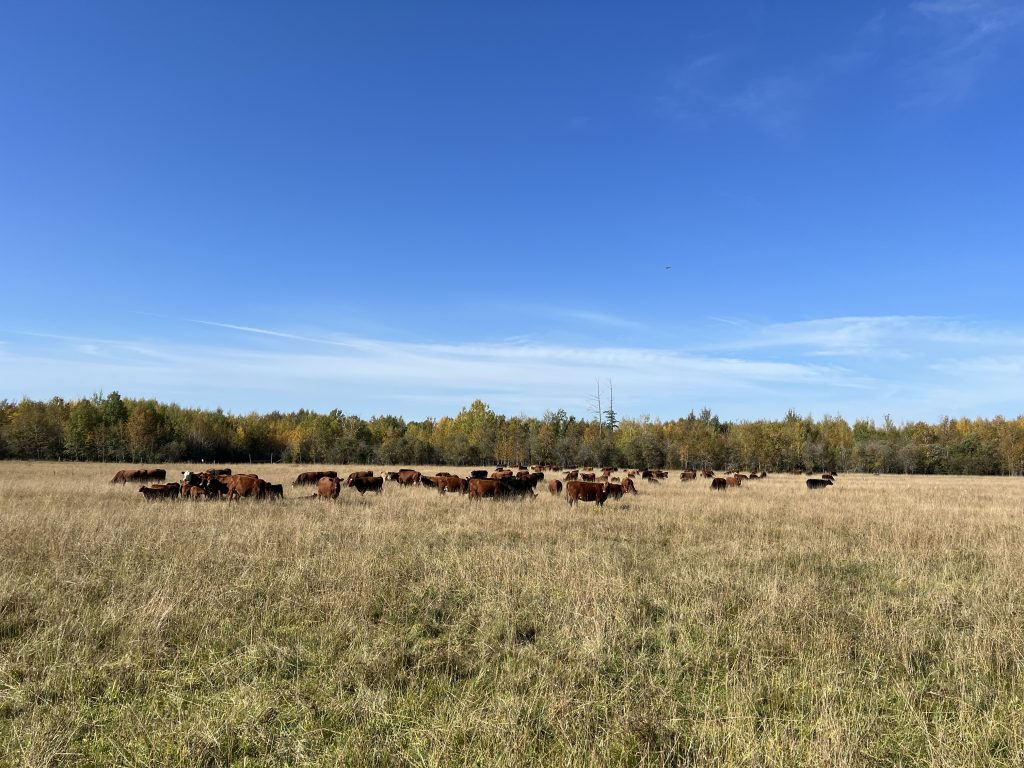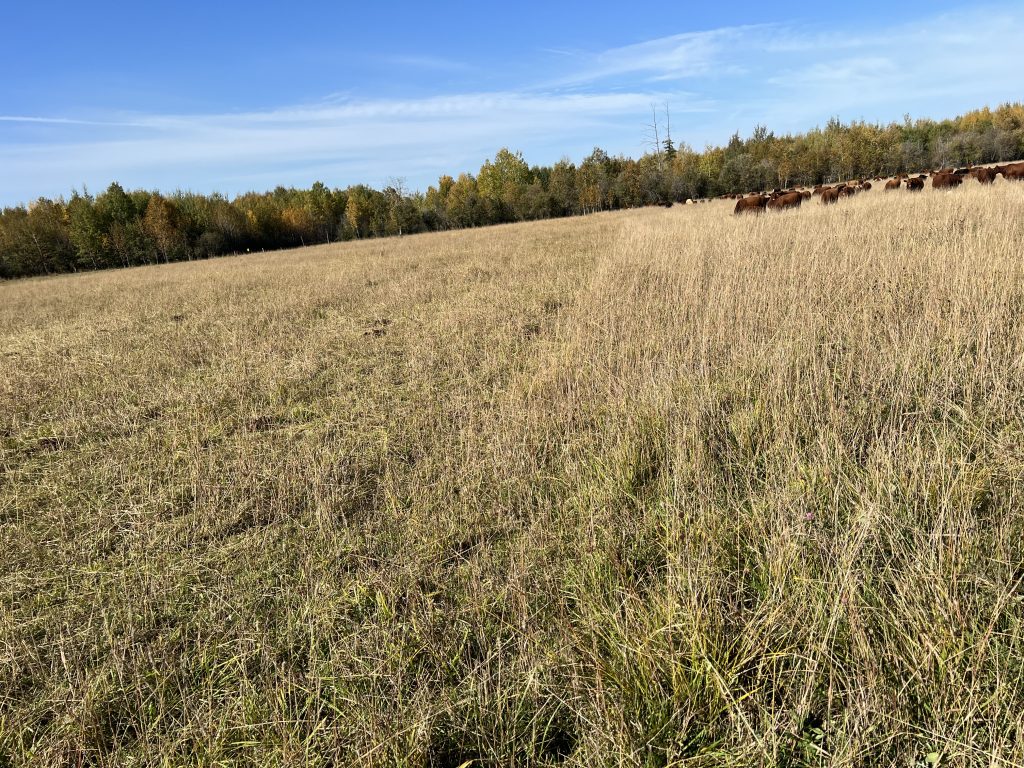By: Emily Seed, Executive Director with the Northern Ontario Farm Innovation Alliance, Regional Communication Coordinator for Northeastern Ontario Soil and Crop Improvement Association

Extending the grazing season in Northern Ontario can be tricky, with shorter growing seasons and the possibility of early snow in the fall months. Beef Farmers of Temiskaming gathered for an educational morning at the farm of Brad Noyes and family on September 30th, 2023 to learn about some extended grazing practices that could be effective in Northern Ontario. Joining the group was Mike Swidersky, manager for the Dufferin/Grey community pasture and expert grazer, as well as Jim Johnston, local “grazing guru”.
Stockpile Grazing:
The Noyes family run a cow-calf to yearling beef operation, with cattle on pasture in the summer and hay in the winter. They calve in June-July, weaning calves in March and then feeding them on grass until late September or early October.
Noyes typically puts cattle out to grass during the last week of May. He has 525 acres that he uses for grazing, 115 which are cleared, with the remaining land being bush. This land is split into seven fields and doesn’t include any additional land that may be saved for stockpile grazing. Noyes manages the bush land as pasture, which works well with his cattle. More work on silvopasture is being done by Christoph Wand at OMAFRA, so more tips on grazing treed land should be available soon.
Noyes showed us a field he usually cuts for hay but didn’t this year because the yield was poor. There was an opportunity to purchase some good quality feed from a neighbour at a similar cost to producing the feed themselves, so he set aside this field for stockpile grazing. The field is roughly 40 acres, split into 10-acre paddocks, which are then split in half. He currently has a group of 112 cows and 90 calves, which are given 5 acres at a time. They are in each section for roughly six days. This averages out to less than two acres per day for this group. When moving the group, he doesn’t worry about a back fence to prevent back grazing, as he isn’t concerned with regrowth this late in the season.
Jim Johnston noted that tall fescue is a great species to include in a forage mix intended for fall grazing because it stays green and holds its quality even after a lot of frost. If it snows, it also stays upright fairly well.
Johnston has been working with his neighbours to graze hay land later in the season that they typically use for cash crop hay. It is a grassier mix that is lower in quality in a dry year, making it not worth it to cut it. He estimates a cost of roughly $28/acre to graze his sheep on this land, which works well for the neighbour as this is roughly equal to what he would make selling the baled hay.

Annual Forages:
Mike Swidersky comes from an area where most farmers are transitioning from pasture to crop land. Because of this, he has established agreements with his neighbours to graze cover crops in the fall to have more access to land for grazing. He either pays a daily rate or provides the cover crop seed in exchange for grazing rights. The cost also depends on the infrastructure available and how much fencing is required. He estimates the cost of grazing yearlings on cover crops comes to $1/day, while grazing sheep comes to $0.25/day. Mike says that building a relationship for cover crop grazing is like going on a first date – if you try it and it doesn’t work out, you can go your separate ways.

He has found that the gains from grazing annual cover crops are better than that of grazing perennials due to the higher quality of feed. The neighbours have also reaped the benefits, stating that their soil tests have shown higher nitrogen levels, allowing them to use less fertilizer. The decreased input costs show that allowing Mike to graze his livestock helps to subsidize the cost of the cover crop in the long run. The soil tests have also indicated an increase in soil organic matter (SOM). Tests from 2009 showed the SOM levels to be 3.9%, compared to the last two years of tests showing SOM at 6-7%.
One thing to keep in mind when grazing cover crops on someone else’s land is the amount of moisture in the ground. If it is a wetter fall, section off a very large area to help evenly spread the mud mess. This will help to limit the animal impact on the field.
When choosing which cover crop to plant, a few things need to be considered, including when you intend to plant the crop and how expensive it might be. Jim commented that spring barley and winter wheat came off in mid-August this year in the Temiskaming district, so there could have been potential to plant a cover crop of oats and get a good amount of growth for grazing. Typically, oats as a cover crop should be left to be grazed as late as possible in the fall to allow for as much growth as possible. Clover planted in the spring is another good option for cover crop grazing. Brassicas are a more expensive option, averaging $4/lbs for seed, which can get quite expensive. Sorghum Sudan grass can be a good option in warmer/dryer conditions as it is very drought-tolerant.
More Information:
The Beef Cattle Research Council (BCRC) has some great information on extended grazing systems, available here: https://www.beefresearch.ca/topics/extended-grazing/
OMAFRA also offers resources on extended grazing: https://omafra.gov.on.ca/english/livestock/beef/news/vbn0804a6.htm
Not sure which extended grazing system is ideal for your farm? The BCRC also offers a checklist to help you evaluate what may work for you: Extended Grazing Checklist.